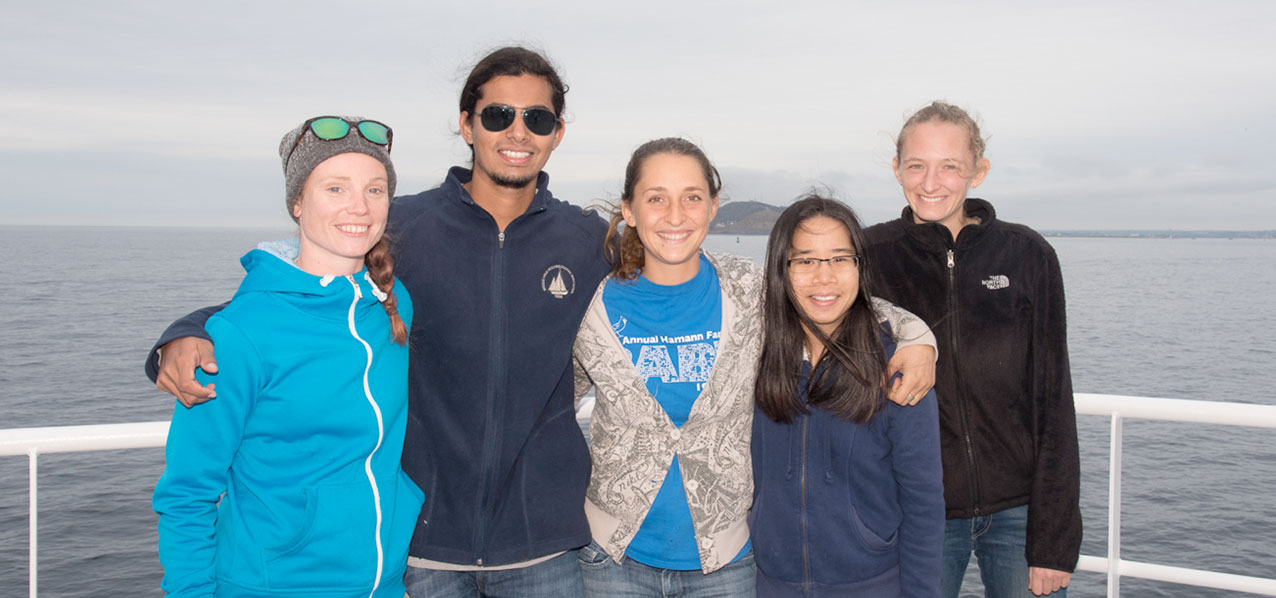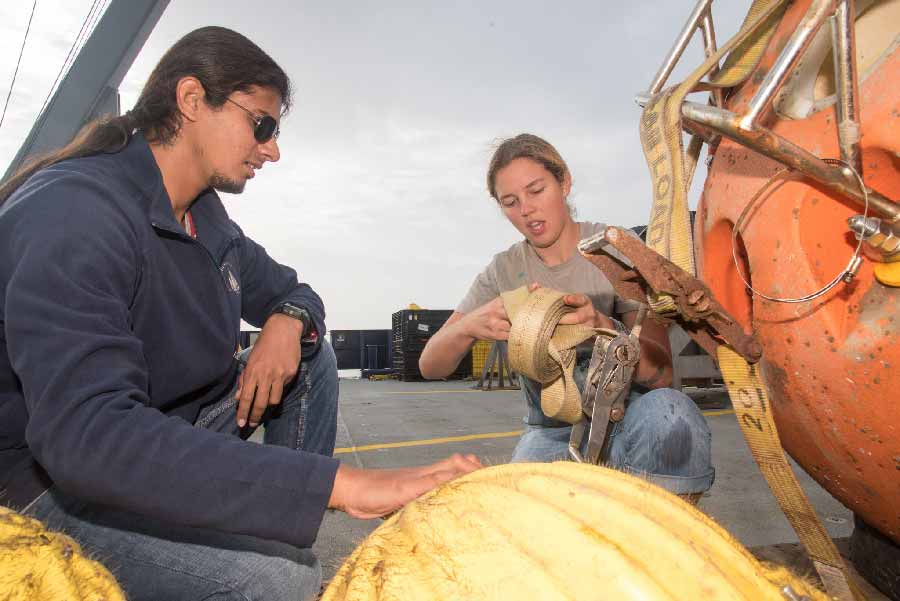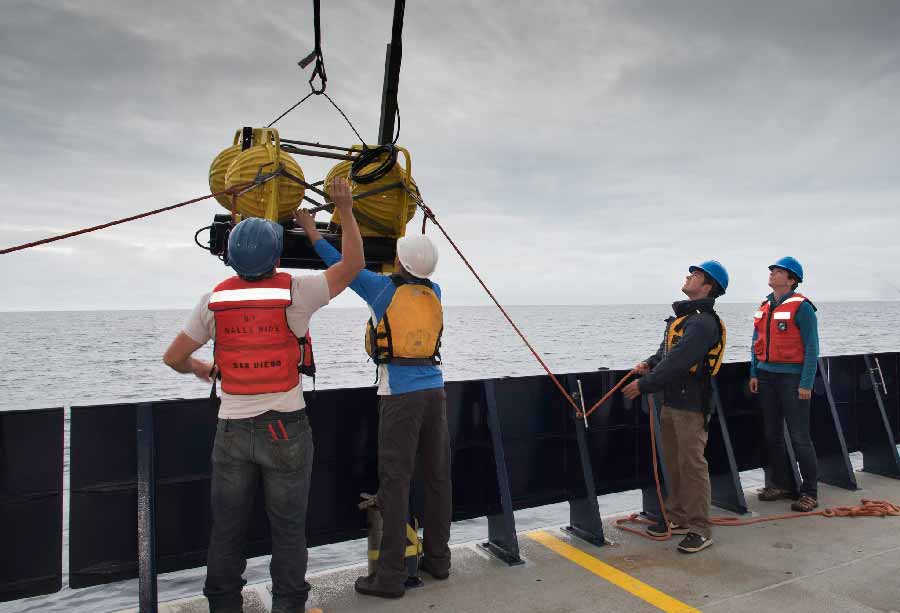
By:
- Brittany Hook
Published Date
By:
- Brittany Hook
Share This:

Scripps graduate students K.C. Cameron, Ratnaksha Lele, Maddie Hamann, Celia Ou, and Effie Fine aboard R/V Sally Ride.
Scripps Graduate Students Get Chance to Put R/V Sally Ride to the Test
Graduate students at UC San Diego’s Scripps Institution of Oceanography recently got an opportunity to try their hand at conducting research aboard the newly launched R/V Sally Ride.
Scripps graduate student Maddie Hamann served as chief scientist of the three-day cruise during which she and her team worked around the clock to collect several moorings that had been deployed three months earlier. The resulting data collected from the moorings will help Hamann, Scripps scientist Matthew Alford, and other researchers answer important questions about wave movements and the internal tide within the La Jolla Canyon.
“We’re trying to study how much energy is in those waves, and what happens to them as they propagate up through the canyon. How do they lose their energy, where do they go? How do they cause mixing and turbulence within the system?” asked Hamann, a fourth year Ph.D. student studying physical oceanography in Alford’s lab.
Hamann said she felt honored, both as a female scientist and a student, to have led a cruise onboard R/V Sally Ride.
“I feel like women in science are really starting to get a lot more recognition now and the coming of Sally Ride kind of fits right in, she said. “Things are changing for sure, and it’s pretty exciting.”
As part of Hamann’s thesis research, she’s studying internal waves and their associated turbulence as they transform and move through the thermocline, the transition layer between the fresh warm water at the ocean’s surface and the dense and cooler deep water below.
State-of-the-art equipment including moorings, acoustic packages, a wirewalker (a vertically profiling instrument carrier powered by ocean waves), and CTD instrumentation (a package that includes sensors for measuring conductivity, temperature, and depth of seawater) make it possible for scientists to investigate internal waves and their impact on coastal ecosystems.
“This is a pretty big experiment to run,” said Hamann, noting the unusual position of being a graduate student in charge of a research cruise.
She chose to attend the graduate program at Scripps for this very reason—the possibility of going out to sea and conducting cutting-edge oceanographic research.
“As soon as I got into San Diego and saw how Scripps is right on the beach and there’s just so many opportunities available, like the UC Ship Funds program, it was easy to decide to come here,” she said.
Scripps graduate student Ratnaksha Lele participated in the cruise as a volunteer. He was also thrilled to have the opportunity to gain shipboard experience, and during the cruise he assisted with the CTD casts.
“It’s been really exciting for me because I’ve never been onboard such a huge ship, and the people are really nice and helpful,” said Lele, a first year student studying physical oceanography. “The experience has been really positive.”

Scripps graduate student Ratnaksha Lele and oceanographic engineer Sara Goheen secure a freshly recovered subsurface mooring to the deck of R/V Sally Ride.
Lele is interested in studying polar oceanography, sea-ice melt, and its interaction with the ocean and how it affects the climate. He hopes to conduct research in the Arctic or Southern Ocean within the next couple years, and a program such as UC Ship Funds could make this a possibility.
“It’s such a unique program and it’s great experience for the student to develop the skills they need to be a chief scientist,” he said.
Although R/V Sally Ride was only in its third week of operation at the time of the December cruise, ship operations went as planned—smoothly and efficiently. The scientists and crew commended the ship’s well-designed layout, stability at sea, and whisper quiet engine.
When the ship drew near the moorings, the scientists pinged a release code and the instrumentation floated to the surface. Next, the scientists and crew used a crane to haul the equipment onboard the ship. Equipment recovery is crucial in order for scientists to collect the data, stored only on internal memory cards within the instruments. Researchers will analyze the data back in the lab in the coming weeks, and Hamann expects to spend the next 2½ years fully analyzing the data collected from this research expedition.
Scripps marine acoustician Ana Širović and several colleagues were also onboard R/V Sally Ride during the research cruise, in which they recovered a combination of passive and active acoustic moorings that have been recording underwater sounds for four months.
Širović and her team utilized a number of High-frequency Acoustic Recording Packages (HARPs)—devices that sit on the seafloor with a suspended hydrophone (an underwater microphone)— to collect acoustic data on marine mammals, as well as echosounders to study their prey. Funded by the Office of Naval Research, Širović’s project is intended to improve understanding of the blue and fin whale populations in the Southern California Bight.
The large data sets retrieved during this cruise will allow the researchers to study the interaction between marine mammals and their prey, including fish, krill, and squid, and answer many other scientific questions. The next step for Širović’s team is to manually analyze the active acoustic data in the lab.

Scripps Assistant Research Oceanographer Ana Širović watches as crewmembers aboard R/V Sally Ride recover a package of acoustics equipment from the La Jolla Canyon.
“There are certain things that we know and expect to find there, and we have automatic detection and processes to extract those things,” said Širović, “but then you want to manually scrutinize the data also, to make sure that everything looks okay, and see if there are any weird and wonderful new things that you weren’t expecting. Those kinds of things you just can’t automate.”
Hamann's cruise was made possible thanks to the UC Ship Funds Program, which provides significant support to enable graduate and undergraduate students, postdoctoral researchers, and early-career faculty to pursue independent research and instruction at sea aboard Scripps ships.
“The UC Ship Funds Program provides the means for our students and early-career professionals to develop the skills they need to succeed, under the mentorship of the world's greatest ocean scientists,” said Scripps Associate Director Bruce Appelgate, head of Scripps Ship Operations and Marine Technical Support. “It also provides the opportunity for students to collect data and test their own innovative sensors in order to advance their own research. The UC Ship Funds Program is a cornerstone of our commitment at Scripps to enable the very best opportunities for our students and scientists.”
Share This:
You May Also Like
Stay in the Know
Keep up with all the latest from UC San Diego. Subscribe to the newsletter today.


